F.C. Volunteer Fire Dept. Hosts National EMS Memorial Bike Riders
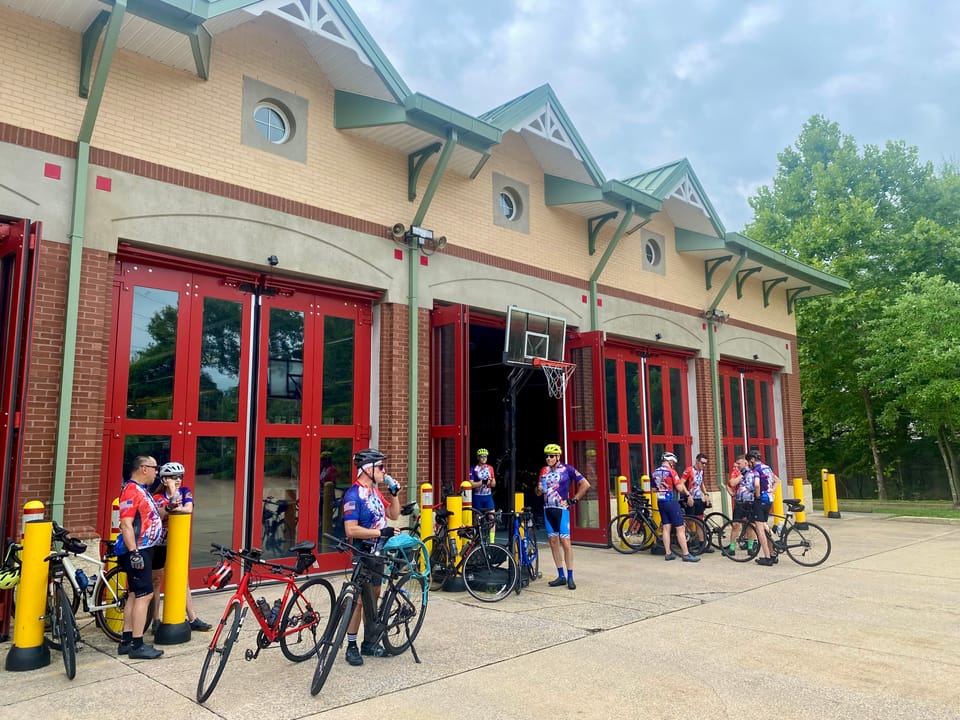
All hail our Emergency Medical Services (EMS) professionals who put their lives on the line in service to the community.
The Falls Church Volunteer Fire Department (FCVFD) along the W&OD Trail at the firehouse on 6950 Little Falls Road, hosted a much-welcomed rest stop for bike riders commemorating fallen EMS providers in Friday’s National EMS Memorial Bike Ride (NEMSMBR), July 18.
This year, the FCVFD commemorates a century of service to our local community. On their website, they declare, “For a century, the [FCVFD] has been at the heart of our community, delivering lifesaving [EMS] and essential safety education. As we celebrate our 100th anniversary in 2025, we remain committed to safeguarding Falls Church and Arlington County with innovation, dedication, and care.”
The National EMS Memorial Bike Ride’s mission is to “honor the service and commitment of [EMS] professionals by organizing and implementing long-distance cycling events,” the organization’s website says.” Their vision is to “reduce illness, injury, and mortality through recognition and promotion of physical and mental well-being.” The group’s been sponsoring these rides of honor for 25 years.
Among the several values the group embraces: “Semper Memoria,” meaning, “We always remember,” “Wellness,” or, “We encourage healthy living through physical, emotional, social, and spiritual fitness,” and, “Awareness,” as in, “We acknowledge the inherent risks faced by our industry professionals.”
Arriving around 9:10 a.m., in the beating July sunshine, the thirsty riders had set off early from the Hyatt Crystal City – host of the National EMS Weekend of Honor – to cover 62 miles (or a metric century) for the day, aiming to ride through Arlington, Falls Church, Vienna, Herndon and back, where they’d be “greeted by family and friends of the 2025 Honorees,” those EMS professionals who fell in the line-of-duty over the last year.
The Falls Church Independent spoke with several participating bike riders detouring off the W&OD Trail and into the FCVFD firehouse for rest, refreshments bathroom breaks – and, in one case, first aid for a bee sting. We also chatted with ride volunteers and a representative for the FCVFD. We were curious about the risks faced by EMS workers in their lines of duty, and the dedicated riders’ personal experiences and perspectives.
Secretary for the FCVFD, Richard Klein, greeted us at the firehouse as we prepared to welcome the peloton of riders. The FCVFD’s been hosting riders for the last three years. “But the ride’s been going for a lot longer than that,” he said. “They were passing the station and somebody came up and said, ‘Jeez, this is a great spot. It’s right in the middle of the route and it’s a great place to have a rest stop.’ And we said we were happy to help.”

“This ride is really to honor the people who’ve served and who’ve died in the line of duty,” Klein said. “And, people know what EMS people do as they put their lives on the line… And [the riders] just need a place to rest and get some ice and some water and use the restrooms…. I’m happy for them to come through the City and to see them here.”
Board Member for the NEMSMBR, Eric Morrison, spoke to us from his bike after grabbing a drink. “We’re out today riding as a group to honor [Emergency Medical Technicians] EMTs and Paramedics from across the country who’ve lost their lives. This weekend there’s actually a ceremony to honor the 29 providers who passed away in the line of duty. Part of our mission is to make sure that the families know their loved ones are not forgotten. They matter to their families, they matter to their communities, and their sacrifices mattered and that’s why we’re all out here sweating in the sun today,” he said.
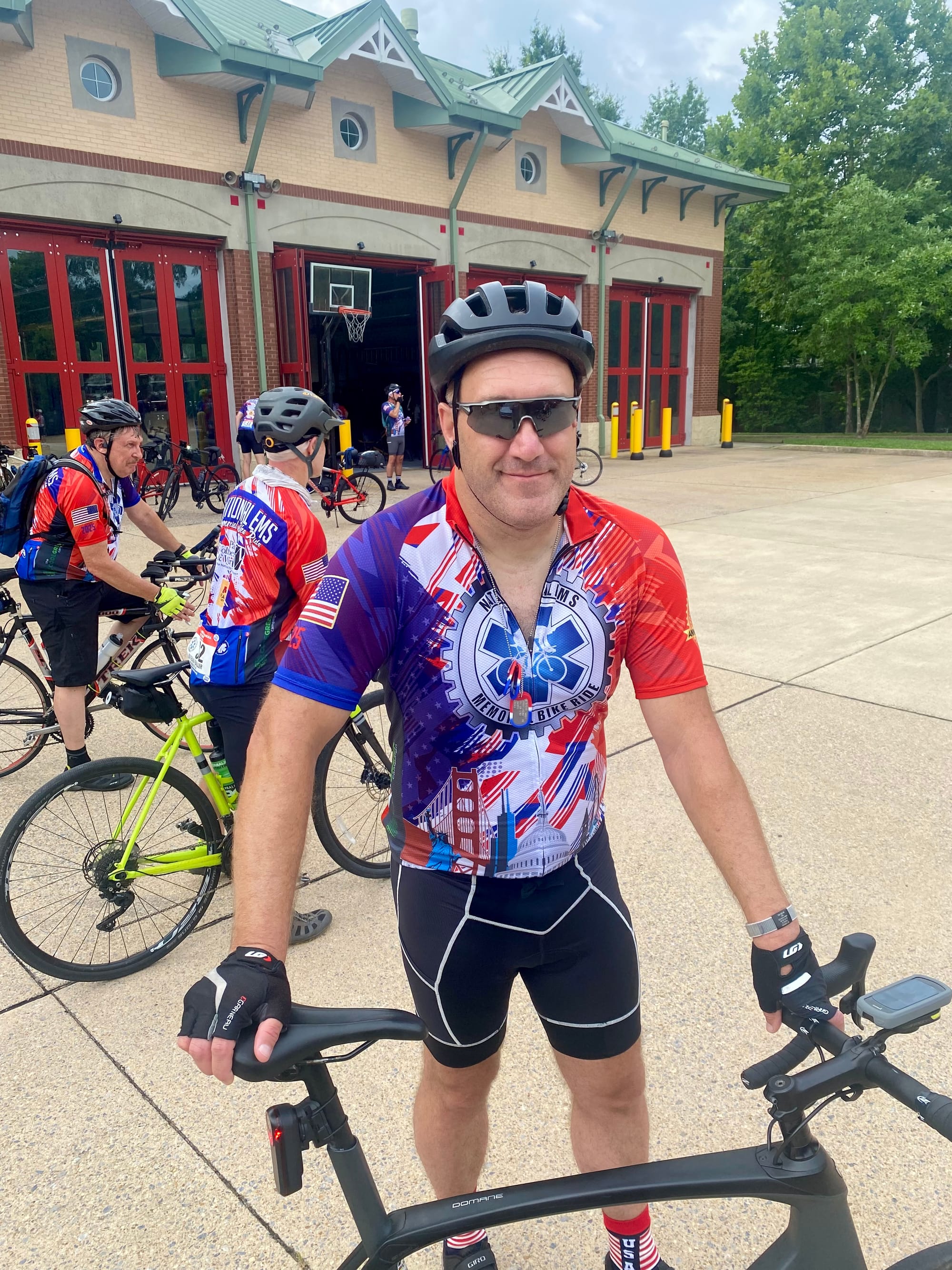
An EMS Director in North Carolina, Morrison has served as a Paramedic for “almost 30 years." After Covid, he got involved in the ride and said, “it’s been a fantastic way to kind of give back to the people that care about their communities.”
Asked about the hazards EMS professionals face in the line of duty, Morrison easily elaborated. “The thing is the job itself is so physically dangerous. You’re just continuously picking up, moving things, moving people, moving stretchers, and equipment, and quite often people don’t really think about the most dangerous parts of our job which is actually going to and from calls,” he said.
“All those miles you’re actually in that ambulance, driving in that vehicle on that road. In my particular service, we average about 60,000 miles per vehicle each year,” Morrison continued. “So, that’s a lot of time on the road. And that just increases the risk because we’re trying to work our way through the traffic. So, it becomes dangerous and that’s where folks at home can help us out and make sure they’re yielding to those emergency vehicles.”
Asked if he knew any honored EMS worker, Morrison said, “I do actually. We had a conversation before we left. This is actually the first year I’ve been here that I’ve not known somebody personally that passed away [during the year]. But Sunday is actually the anniversary of the death of one of the providers that worked with me. She did die in the line of duty. And we do honor all those that sacrifice even though we focus particularly on the line-of-duty deaths this weekend.”
“These fire stations are opening up to help us out and give us an opportunity to use the rest room, get re-stocked with water, and all of that kind of stuff and so we really appreciate the welcome,” Morrison said.
“I’m riding to memorialize the fallen EMS people,” said Jennifer Scott, Assistant Chief Nursing Officer for the local Piedmont EMS, “and, I’m riding for one of our EMS [proffessionals], Chelsea Jackson…. She passed away last year. Actually, three days from today will be a year…. I have her dog tags and I’m riding in honor of her."
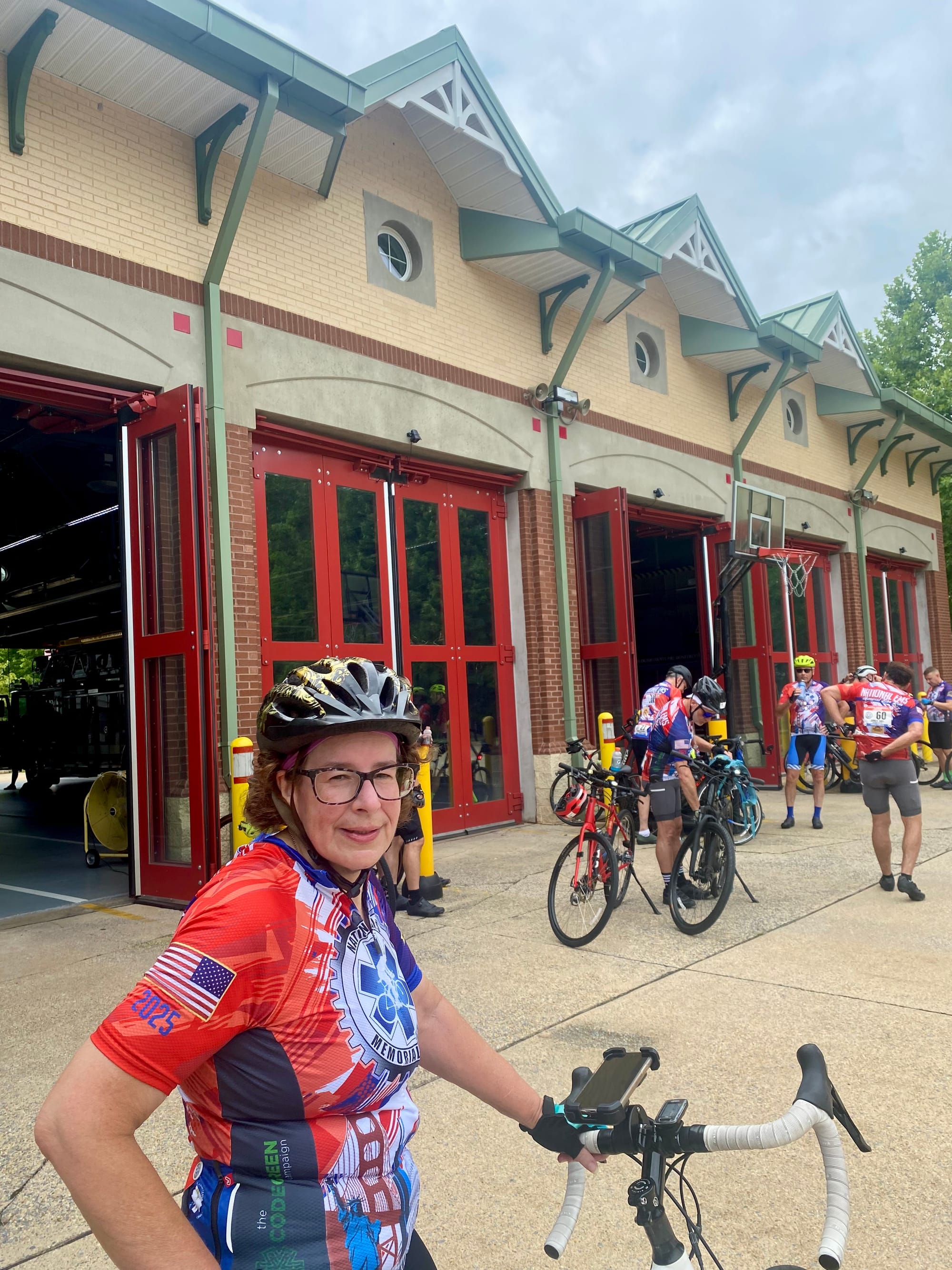
From Scott’s perspective as a nurse of 27 years, she’s well-acquainted with the hazards EMS professionals face. “I’m the nurse that – when they bring the patient to me – they’ve already done all the hard work,” she said of Paramedics and EMTs. “I think anything in health care is dangerous because they’re the first responders, right? It’s like the police. They come onto the scene and they have no idea what they’re going to find. So they have to secure the scene, they have to treat the patient, and all that’s a pretty dangerous job as well as a big responsibility.”
EMS workers tend to work in chaotic situations, Scott emphasized. “Shootings, stabbings, gang activity, car accidents,” she rattled off. “You know, we’ve had EMS people be injured by getting hit by cars because they’re securing a car accident.”
“I’d just like to say thank you for covering this event because look at all these people,” Scott said, pointing to all the bikers. “They come out to do all this to honor fallen friends and family and just to honor everybody.”
An EMT from Washington, D.C., John (no last name provided), fortunately hasn’t known any fallen EMS workers, but finds the EMS profession highly rewarding as well as, so far, the day’s ride, his first. He even planned to tag an extra 14 miles onto his day’s journey, commuting both ways between his home in D.C. and the ride’s Crystal City starting point.

John emphasized that EMT’s are “well-trained,” and understand that “Rule #1 is that we ask ourselves, ‘Is the scene safe?’ And, If it’s not, it’s either a police matter or a utility company matter or something like that. So, generally we don’t go in unless it’s safe.” Nevertheless, he acknowledged, “Sometimes things do happen.”
“I’ve been an EMS for about three years and it’s just one of the most rewarding things I’ve done. And definitely kudos to these support staff. It’s definitely one thing to ride; you're getting your exercise. But the support staff put in countless hours and they’re just incredible.”
Trauma Nurse, Cindy Anthony, was riding “for everyone who was lost and their memories and all that served and continue to serve.” Her years of medical experience gives her a unique perspective on what EMS professionals face. “I’m kind of an old EMS person,” Anthony said. “I went through training in the 80s, was an ER nurse for a while, ICUs. And now I do Trauma.”
Anthony points to the less-understood risks many EMS workers face, as do many in health care generally. “Burn out, compassion fatigue. Of course you have mental health concerns, behavioral emergencies, infectious diseases, but more so the compassion fatigue. We all are compassionate people. We don’t go into this business to make money. We go because we care for others. And it’s hard for us sometimes. It’s very hard for us,” she said. “We thank Falls Church for your hospitality,” Anthony said before riding off.
Next we encountered a longtime veteran of the ride, Tim Perkins. Turns out, he was the one who originally asked the FCVFD to host the riders coming off the W&OD Trail three years ago. “I’ve been with this ride for 18 years. One of the things I’m pretty proud of is that it’s been 18 consecutive – I haven’t missed a year.”
Perkins has also seen the risks EMS workers faced from many angles given his varying jobs in the medical field. “I work for the State Department of Health here in Virginia. I live in Richmond and years ago a friend of mine turned me on to this ride and said, ‘You’re gonna have a great experience.’ And, I’ve been an EMS for a long time and this is one of the most rewarding things I’ve ever done,” Perkins said.
“This is the first time in a handful that I haven’t had other responsibilities. I’ve been a member of the Board, I’ve been the [Public Information Officer] PIO, and route coordinator,” Perkins continued. “I worked as a Paramedic and in EMS administration for quite a few years. And for a long time I worked for the State Office of EMS for kind of the regulatory part of EMS in the state. And a funny story: I was here for a meeting and I recognized how close we were to the trail, so I asked Richard [Klein] if he would be willing to open up the firehouse…. And Falls Church has been terrific. They’ve been incredibly accommodating and that’s all we can ask for.”
Concerning the hazards of the EMS professions, Perkins also had a unique take. “It’s funny because the people who go through training are well-trained and they know their jobs and they know their stuff. But, I feel like sometimes – and this isn’t a criticism – but, I feel like sometimes, EMS kind of is second fiddle to Police and Fire. But, I think that’s changing. If you ask any fire department or EMS agency in the state, they’ll tell you that 80 percent of their calls are EMS. And they only do 20 percent Fire or Rescue or whatever.”
“I mean, if there were a call here the chances are pretty good that an ambulance would roll. If there were a car accident out here, there would be an ambulance that would roll out with the rescue truck,” Perkins said.
Some of the greatest hazards EMS workers face, however, often have to do with stress-related illnesses. “Unfortunately, EMS providers don’t necessarily always take great care of themselves. We take great care of our patients, but we don’t tend to take great care of ourselves,” Perkins said. “There’s some obesity, and you’ll find that there are still providers that smoke and things like that. Part of what we’re doing here is not only honoring people who died in the line of duty, but we’re advocating for safety and better health for EMS providers.”
As a state health administrator, Perkins views EMS stress as varying from system to system. “My own personal experience is you’re walking into someone’s house when they’re at their most vulnerable and that’s a lot of pressure and a lot of responsibility. Even for the most basic things. If somebody falls on the floor and you pick them up and put them back on the chair, you’re still going into their house, which is sometimes an intrusion.”
But it’s the never-ending nature of the stress that takes its toll, Perkins believes. “The toughest part is it’s a grind, you know? And, it’s unrelenting. And with a busy system, if you’re working 7A to 7P, you might get out at 7P, but you may not because the system’s overloaded. Burnout – they’ve done studies. Usually the average time within an EMS career is only about 4 or 5 years.”
Finally, we spoke with Paramedic, Flight Medic, and 20-year EMS worker from North Carolina, Kerry Bering, Support Volunteer for the ride. “I’ve been doing the ride since 2018. I’ve done the Weekend of Honor as well as the East Coast Route every year,” she said.
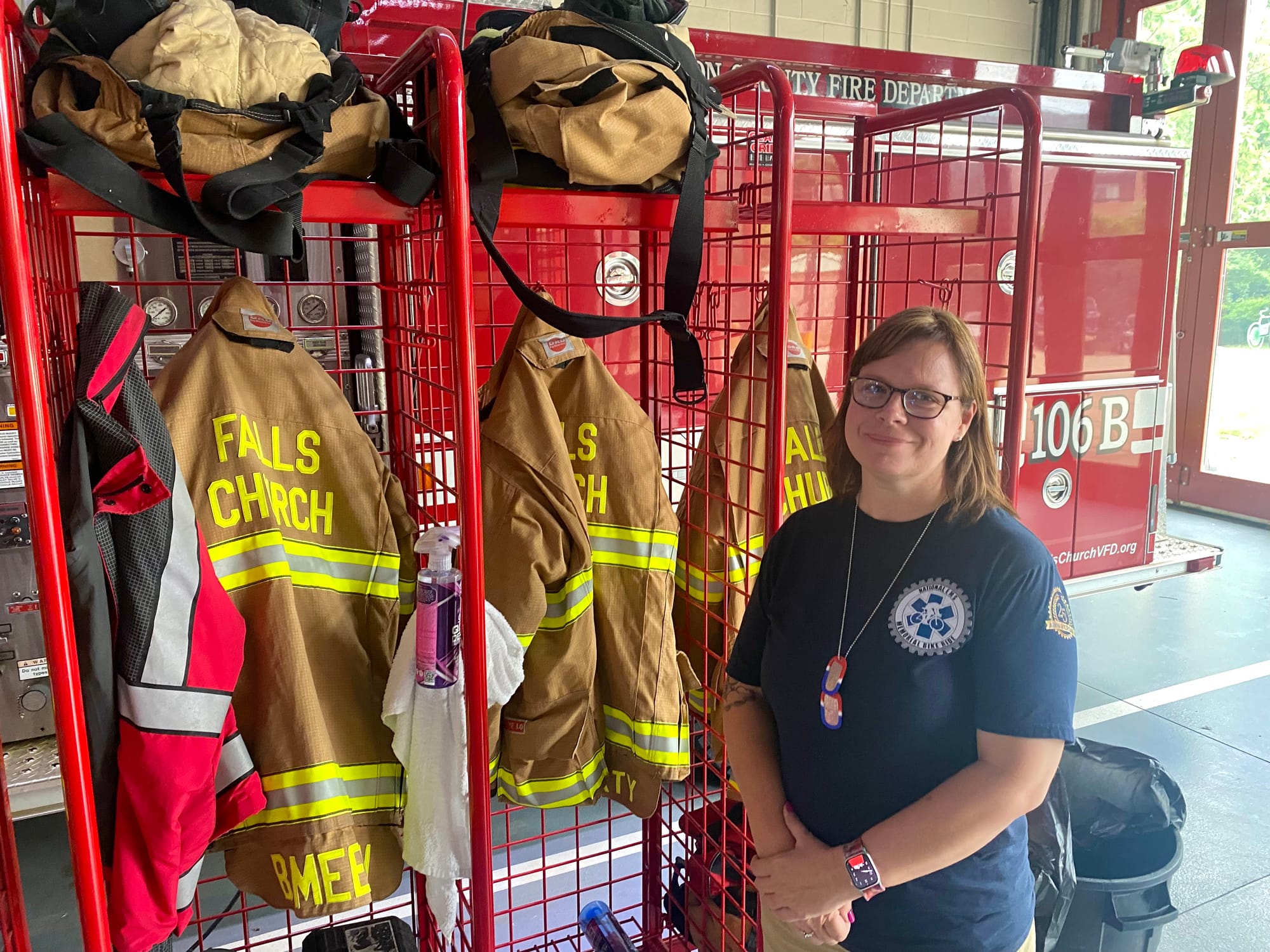
But the grueling 500-mile East Coast trek sponsored by NEMSMBR took it’s toll, so Bering was sitting out the ride for the day and concentrating on helping out the riders in any way they needed. “In the past, I was a previous Board member. I’ve been a cyclist. And today I’m on the ‘Injured Reserve List,’ as we kind of call it.” [Laughs]. “But, I’m fine. I’m just here to support and make sure everybody has what they need and if anybody needs any help or assistance.”
Of all the riders we encountered, Bering was the most quickly moved to tears as she described the dog tags she wore and carried along with her. “So, my honoree is Andrew Humphrey,” she explained. “I’ll be seeing his son again today. I actually taught his son in Paramedic school a couple of years ago. We worked as instructors together for a little bit. He was also in law enforcement and paramedic care in the Northern Virginia area and I believe he also worked for Fairfax. And he passed away – it was not a line of duty death – but he passed away in 2024. So, I’m riding for him. I rode the East Coast for him…. For the East Coast route, we go from Boston to D.C. every year in May. So, we cycle for 7 days.
Bering carries a satchel of dog tags with her to commemorate the fallen. “So, the sack that I have from previous years is kind of big,” she confessed. “I’m trying to – like, I’m getting chills right now – umm, So, when I’m cycling I put them in my cycling bag in my saddle. And it actually kind of makes my neck sore to wear all of them. So, they’re in my care, but I’m wearing Andy today, to remember him.”
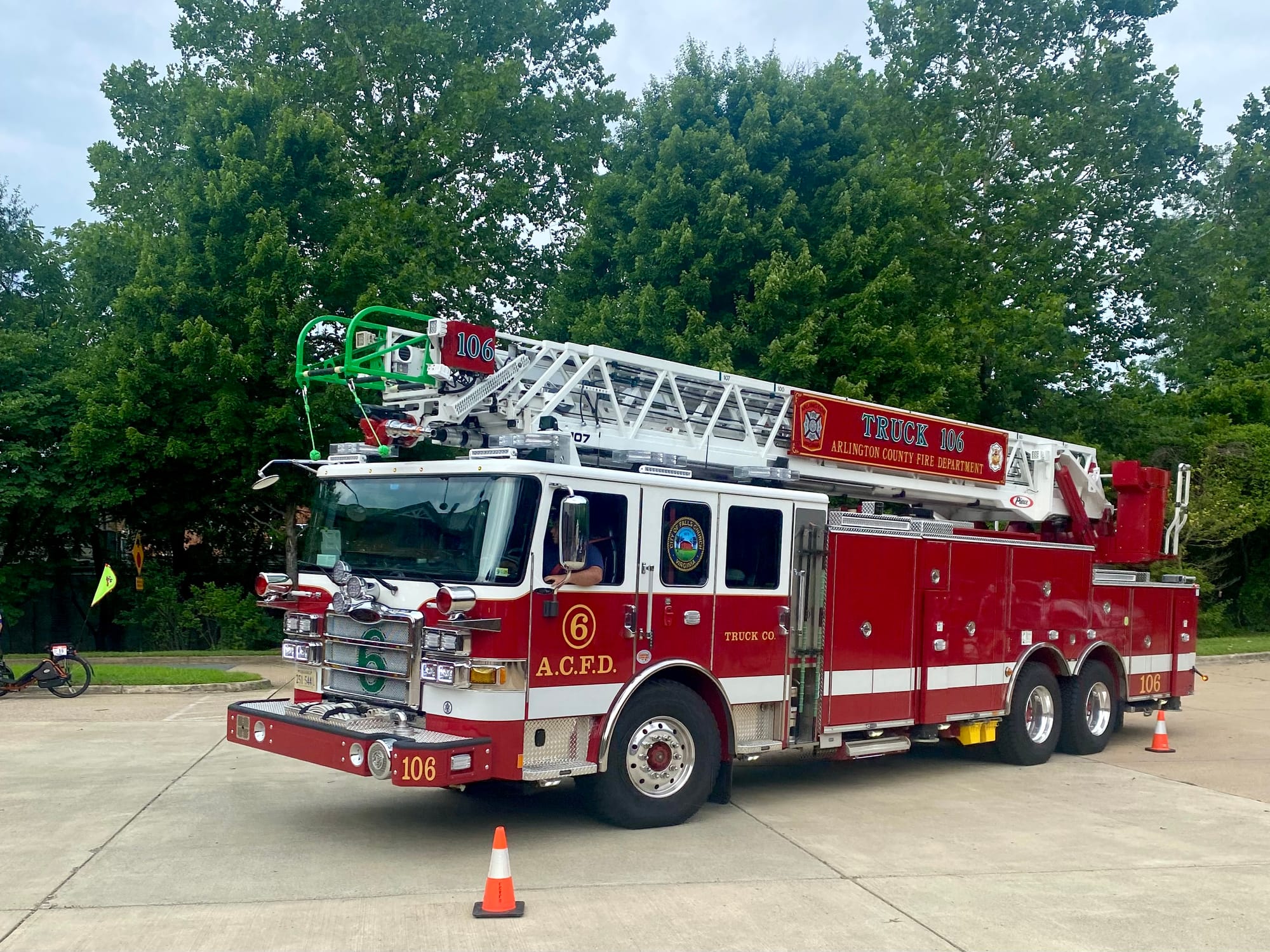
“But one of the things with the dog tags is we all wear them, and we save one we wear for ourselves through the rest of our journeys and one goes to the family member,” Bering continued. “So, when I see Nick later today, I’ll present him with his dad’s dog tag that I’ve been carrying since day one of East Coast this year. And it will be a ceremony over at Sterling later today. So, I’ll present him with that tag.”
“And these tags have been with me through 500 miles on East Coast, through rain and sunshine and everything else. So, the tags are especially important to me, I guess, because I kind of see it as a physical representation of the people I’ve honored in years past. But, I’m not a pro-cyclist by any means. So, when I struggle on some of these hills, I’ll kind of call to them in my own mind. I’ll be like, ‘Andy, help me out here.’ Or, for Clint, or whoever the names I have on my list – I’m going to get choked up here – So, I kind of feel like these individuals in EMS, and how we are as Paramedics and EMTs, that we wouldn’t give up on each other, and that they wouldn’t give up on me. So, I can’t give up on them.”
“Thank you for being out here and capturing our stories today,” Bering added. “We always want to appreciate the people we lost.”
By Christopher Jones



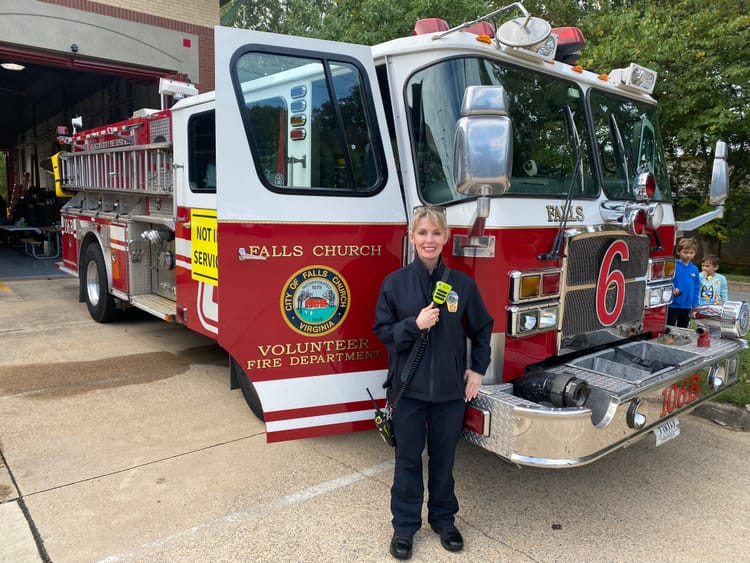

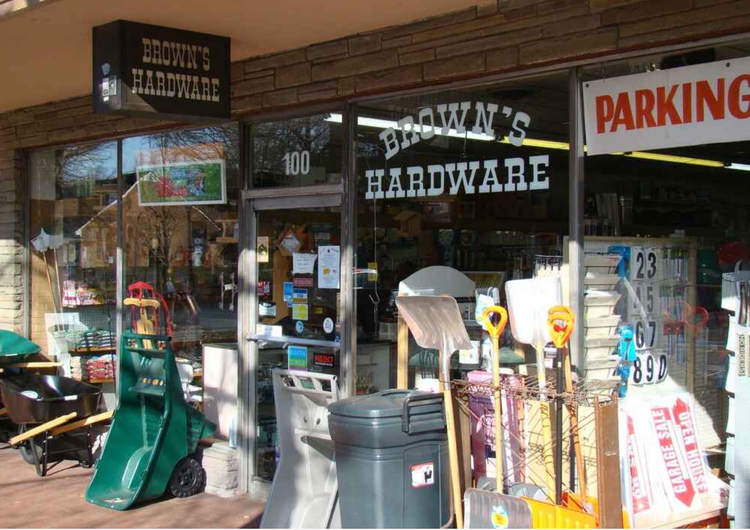
Member discussion